Abstract
Patients with IgA nephropathy show an emergence of IgA dominant circulating immune complexes (CIC) as well as increased levels of serum IgA and/or IgA bearing peripheral blood lymphocytes. In order to elucidate immunological aberrations responsible for the increased IgA synthesis in such patients, quantitative and qualitative analysis was performed on T alpha cells which have been recently identified as possessing IgA specific helper activity on human B cells. Three different methods were employed to quantitate T alpha cells. These methods included a rosette formation of T cells with either bovine red cells coated with the IgA fraction of anti-bovine red cell antiserum or those coated with TNP and anti-TNP IgA antibody, and an analysis of T cells combined with fluorescein conjugated human IgA myeloma protein. T alpha cells were sorted by a fluorescence activated cell sorter and co-cultured with a B cell rich fraction to evaluate whether there is a qualitative difference in IgA specific helper activity between patients and healthy adults. T alpha cells were significantly increased in patients with IgA nephropathy while there were no significant changes in patients with chronic proliferative glomerulonephritis without mesangial deposition of IgA. There was no qualitative difference in IgA specific helper activity of T alpha cells between patients and healthy adults. It is suggested that increased levels of T alpha cells in patients with IgA nephropathy may be responsible for increased synthesis of IgA in such patients.
Full text
PDF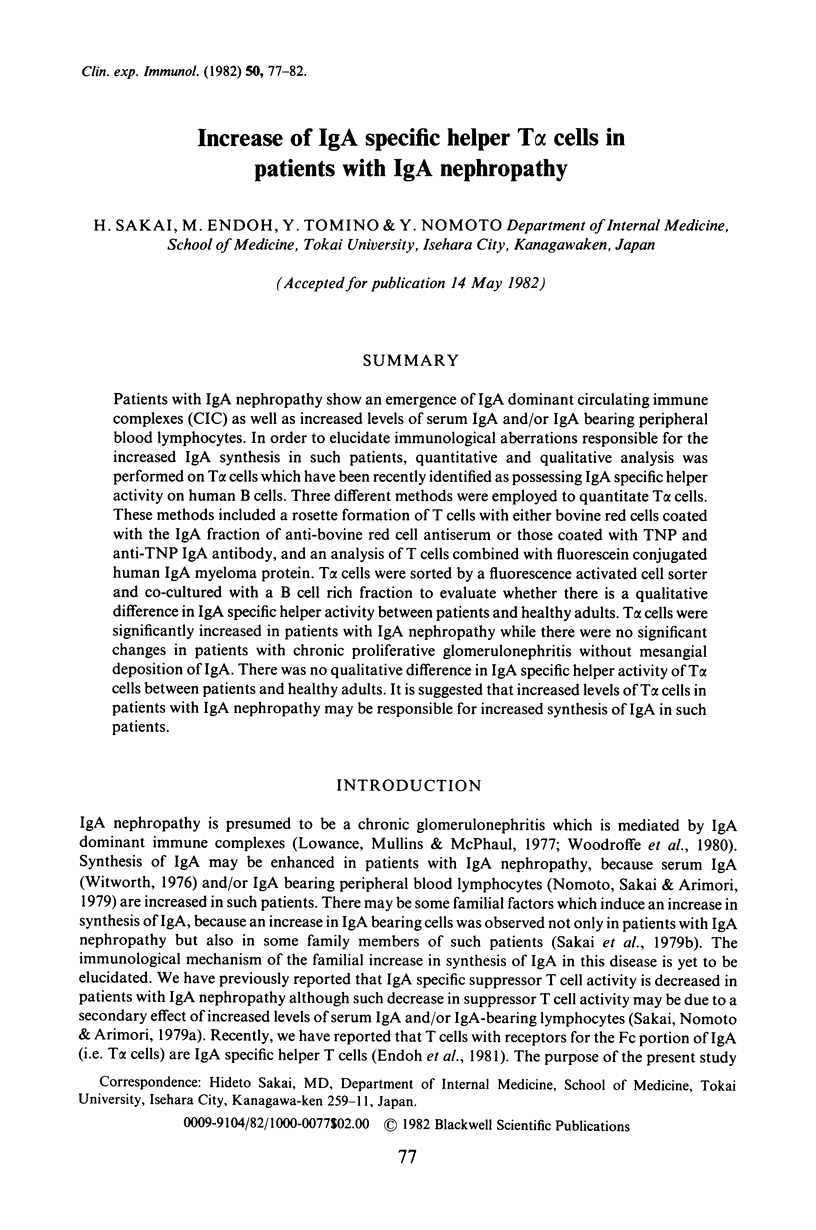
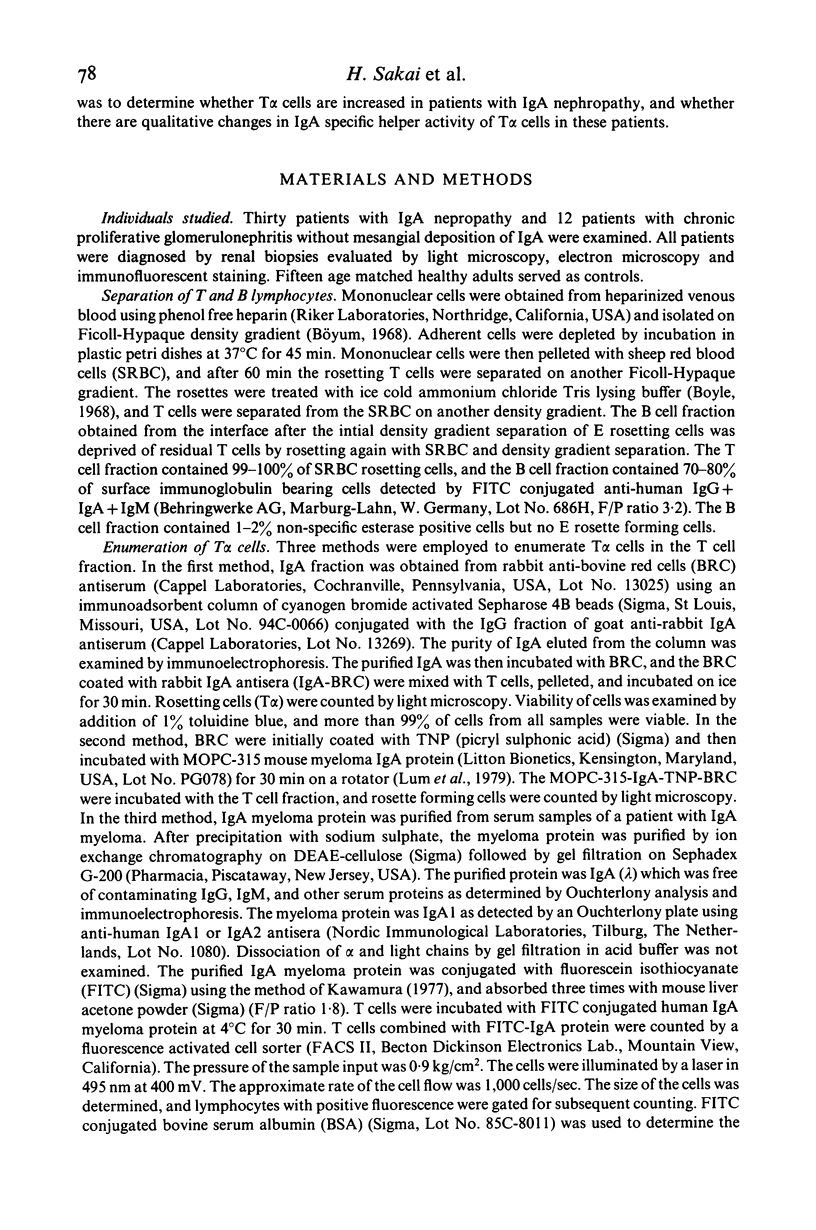

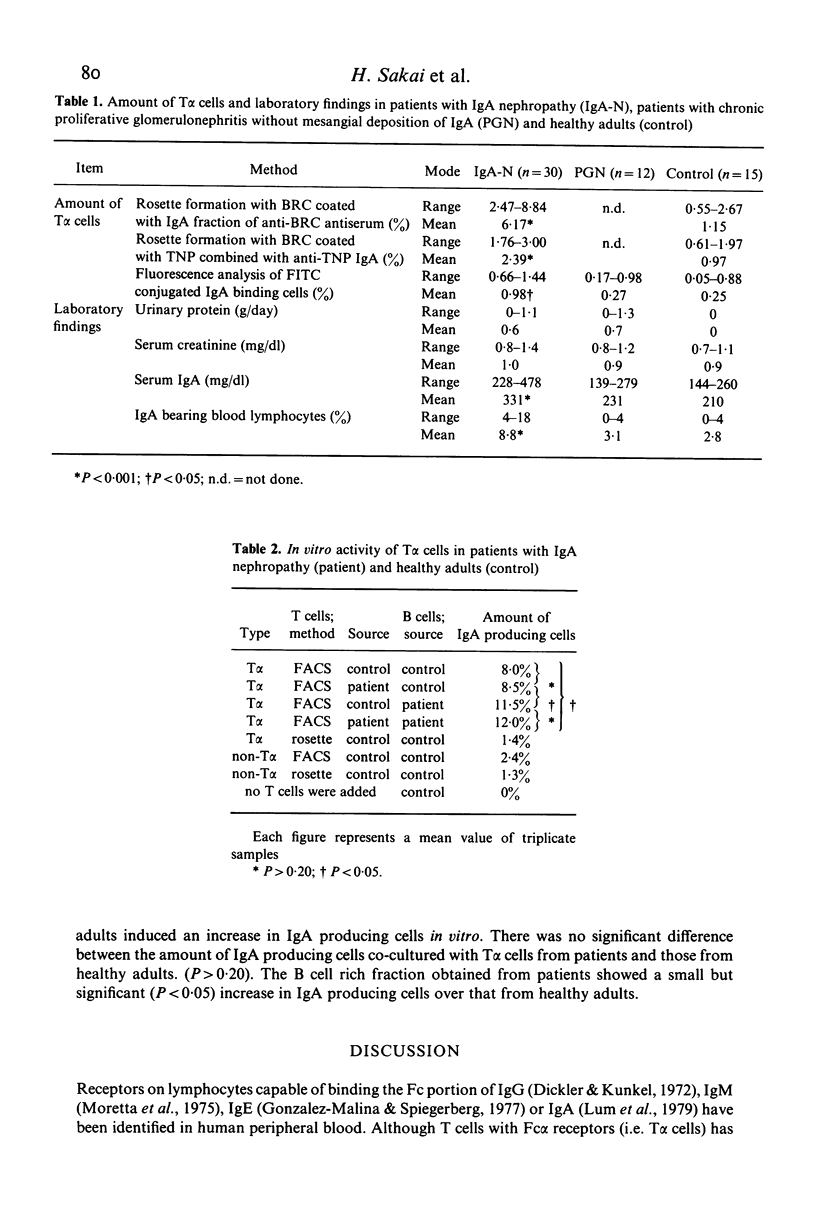
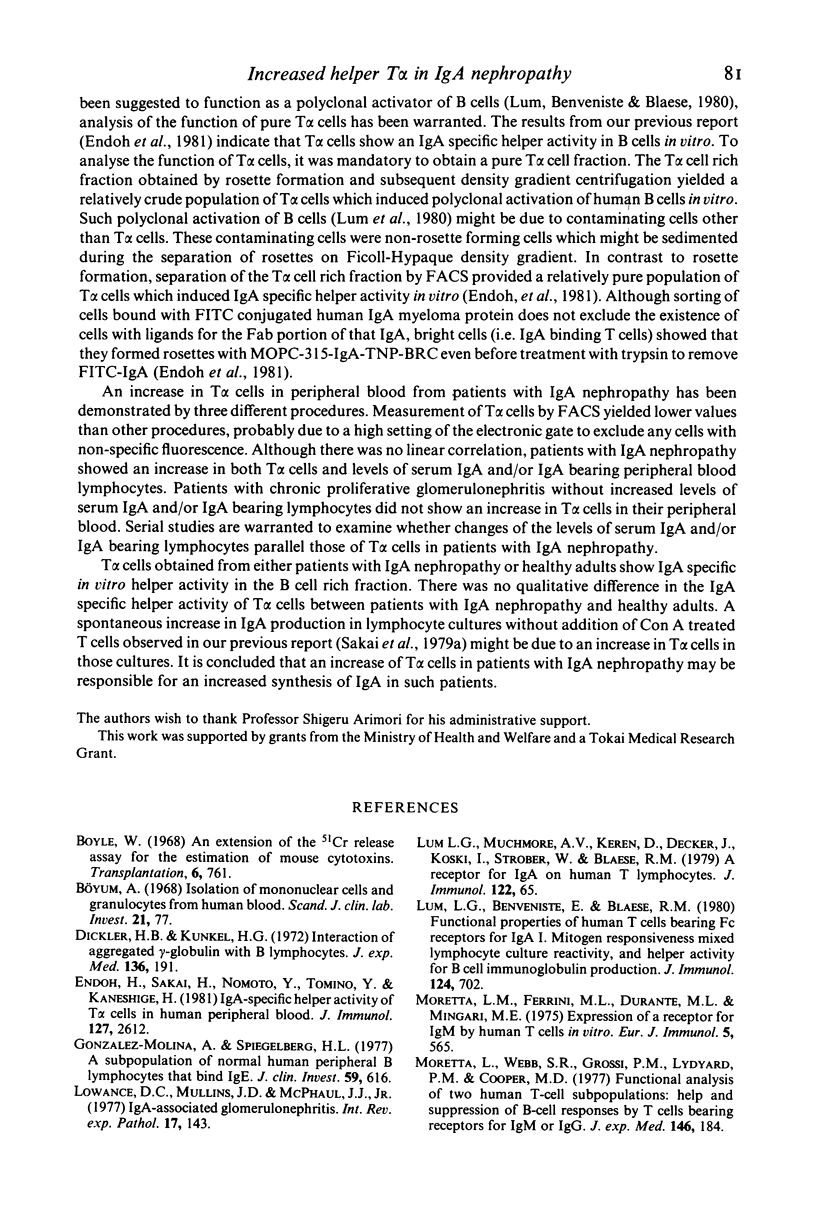
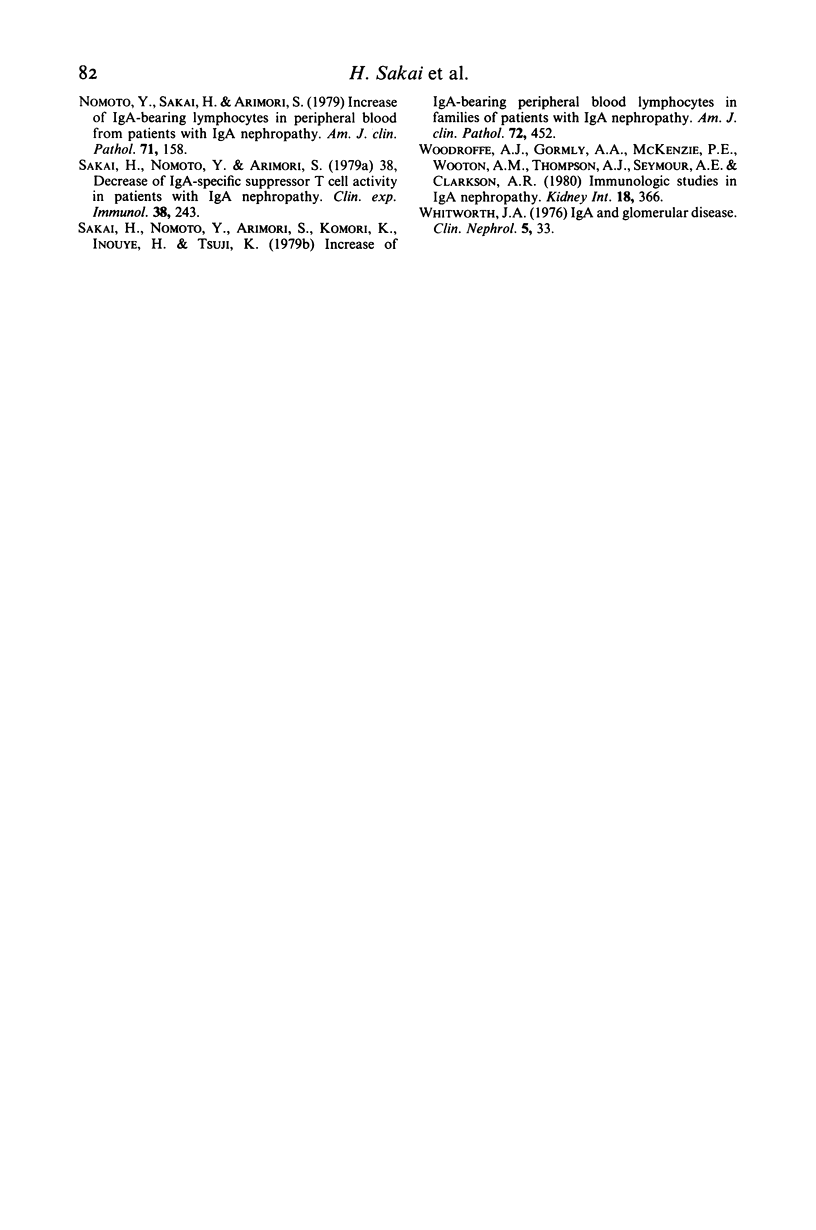
Selected References
These references are in PubMed. This may not be the complete list of references from this article.
- Boyle W. An extension of the 51Cr-release assay for the estimation of mouse cytotoxins. Transplantation. 1968 Sep;6(6):761–764. doi: 10.1097/00007890-196809000-00002. [DOI] [PubMed] [Google Scholar]
- Böyum A. Isolation of mononuclear cells and granulocytes from human blood. Isolation of monuclear cells by one centrifugation, and of granulocytes by combining centrifugation and sedimentation at 1 g. Scand J Clin Lab Invest Suppl. 1968;97:77–89. [PubMed] [Google Scholar]
- Dickler H. B., Kunkel H. G. Interaction of aggregated -globulin with B lymphocytes. J Exp Med. 1972 Jul 1;136(1):191–196. doi: 10.1084/jem.136.1.191. [DOI] [PMC free article] [PubMed] [Google Scholar]
- Endoh M., Sakai H., Nomoto Y., Tomino Y., Kaneshige H. IgA-specific helper activity of T alpha cells in human peripheral blood. J Immunol. 1981 Dec;127(6):2612–2613. [PubMed] [Google Scholar]
- Gonzalez-Molina A., Spiegelberg H. L. A subpopulation of normal human peripheral B lymphcytes that bind IgE. J Clin Invest. 1977 Apr;59(4):616–624. doi: 10.1172/JCI108679. [DOI] [PMC free article] [PubMed] [Google Scholar]
- Lowance D. C., Mullins J. D., McPhaul J. J., Jr IgA-Associated glomerulonepbritis. Int Rev Exp Pathol. 1977;17:143–172. [PubMed] [Google Scholar]
- Lum L. G., Benveniste E., Blaese R. M. Functional properties of human T cells bearing Fc receptors for IgA. I. Mitogen responsiveness, mixed lymphocyte culture reactivity, and helper activity for B cell immunoglobulin production. J Immunol. 1980 Feb;124(2):702–707. [PubMed] [Google Scholar]
- Lum L. G., Muchmore A. V., Keren D., Decker J., Koski I., Strober W., Blaese R. M. A receptor for IgA on human T lymphocytes. J Immunol. 1979 Jan;122(1):65–69. [PubMed] [Google Scholar]
- Moretta L., Ferrarini M., Durante M. L., Mingari M. C. Expression of a receptor for IgM by human T cells in vitro. Eur J Immunol. 1975 Aug;5(8):565–569. doi: 10.1002/eji.1830050812. [DOI] [PubMed] [Google Scholar]
- Moretta L., Webb S. R., Grossi C. E., Lydyard P. M., Cooper M. D. Functional analysis of two human T-cell subpopulations: help and suppression of B-cell responses by T cells bearing receptors for IgM or IgG. J Exp Med. 1977 Jul 1;146(1):184–200. doi: 10.1084/jem.146.1.184. [DOI] [PMC free article] [PubMed] [Google Scholar]
- Nomoto Y., Sakai H., Arimori S. Increase of IgA-bearing lymphocytes in peripheral blood from patients with IgA nephropathy. Am J Clin Pathol. 1979 Feb;71(2):158–160. doi: 10.1093/ajcp/71.2.158. [DOI] [PubMed] [Google Scholar]
- Sakai H., Nomoto Y., Arimori S. Decrease of IgA-specific suppressor T cell activity in patients with IgA nephropathy. Clin Exp Immunol. 1979 Nov;38(2):243–248. [PMC free article] [PubMed] [Google Scholar]
- Sakai H., Nomoto Y., Arimori S., Komori K., Inouye H., Tsuji K. Increase of IgA-bearing peripheral blood lymphocytes in families of patients with IgA nephropathy. Am J Clin Pathol. 1979 Sep;72(3):452–456. doi: 10.1093/ajcp/72.3.452. [DOI] [PubMed] [Google Scholar]
- Whitworth J. A., Leibowitz S., Kennedy M. C., Cameron J. S., Chantler C. IgA and glomerular disease. Clin Nephrol. 1976 Jan;5(1):33–36. [PubMed] [Google Scholar]
- Woodroffe A. J., Gormly A. A., McKenzie P. E., Wootton A. M., Thompson A. J., Seymour A. E., Clarkson A. R. Immunologic studies in IgA nephropathy. Kidney Int. 1980 Sep;18(3):366–374. doi: 10.1038/ki.1980.147. [DOI] [PubMed] [Google Scholar]


